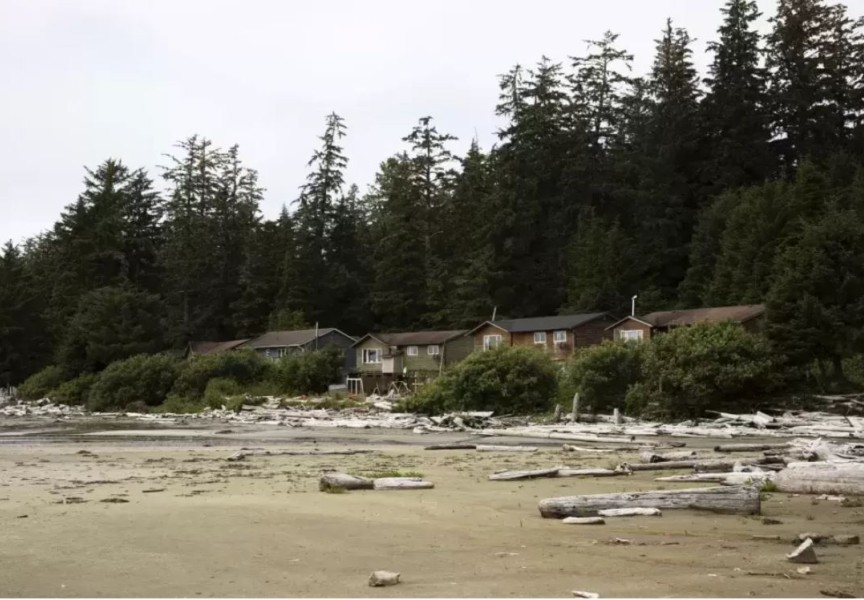The Independent Investigations Office (IIO) has released its report on the July 16, 2020 death of James Williams. The Tla-o-qui-aht/Yucluthaht father of five was found dead in his shelter unit less than a day after being detained in RCMP cells for public intoxication.
Williams, 52, was spotted lying across the concrete base of a business sign beside a busy highway intersection at about 4:30 p.m. on July 15, 2020. A Duncan RCMP patrolling the area stopped to check on Williams and determined that he was too intoxicated to care for himself. The IIO report notes that Mr. Williams was calm and cooperating with the police but was “significantly intoxicated”.
Public intoxication isn’t an offence under Canada’s Criminal Code, but often police will take someone into custody if it’s determined that they are a danger to themselves, said Corp. Chris Manseau of RCMP media relations.
“For the most part it’s so that someone can care for that person if we feel that they’re unable to care for themselves,” he said. “Maybe they’re going to walk into traffic or make a bad decision. They could choke on their vomit or what have you.”
The officer who found Williams determined that he was too intoxicated to be released to the shelter where he lived.
“He was too intoxicated for the sobering centre, but not intoxicated to the point he required medical attention. So, I felt that the cells was the safest and best place for him,” the officer is quoted as saying in the IIO report.
Oddly enough, people using the sobering center need to be able to dress and undress themselves before being allowed in. Williams needed help standing and walking, but was considered not drunk enough to send to the hospital.
The officer told investigators that there would be no one at the Warmland Shelter to monitor Mr. Williams but there is a guard in cells who would monitor him.
Mr. Williams was described as a model prisoner by the cell guard who watched him. He was not placed in handcuffs during his ride to the RCMP station.
Williams was released from cells at about 1:30 a.m. on July 16. Williams asked for the number of a taxi but none were operating at that time, due to the pandemic. So, Williams set off on foot for an estimated 15-minute walk to the shelter he called home.
Commercial surveillance cameras captured Williams as he walked toward Warmland Shelter. A camera in the shelter showed that he had gone to the laundry room at 5:54 a.m. on July 16. That was the last recorded activity until he was found later that afternoon, deceased on the floor of his room by shelter staff.
Because of the fact that his death occurred in close proximity to the time he was detained by the RCMP, the Independent Investigations Office of BC immediately launched an investigation.
On July 17, 2020, the IIO said it would investigate to determine what role, if any, the officers’ actions or inaction may have played in the death of Mr. Williams.
“The BC Coroners Service is also conducting an independent investigation to determine how, where, when and by what means he came to his death,” the IIO said in a statement.
The IIO is the independent civilian oversight agency of the police in British Columbia. It investigates all officer-related incidents that result in serious harm or death, whether or not there is any allegation of wrongdoing.
At the time of his death, family members said Williams had spent time in the hospital after a bout of pancreatitis a day or so before his passing. They were informed that Williams appeared to have a head injury.
The seven-page IIO report chronicles Williams’ time in police custody based on witness testimony, police notes, RCMP custody records, video from RCMP and commercial premises along with autopsy and toxicology reports.
The toxicology report notes “nothing contributory to death”.
The autopsy report lists the cause of death as a subdural and subarachnoid hemorrhage – bleeding on the brain. The report estimates that a bruise on the back of Mr. Williams’ head occurred within approximately seven days prior to his death.
“The subdural hemorrhage was consistent with an older bleed having occurred about four to five days before death and a recent re-bleed occurring within approximately seven hours before death,” states the report.
The autopsy report further indicates that Mr. Williams suffered from other serious health conditions, most notable is there was evidence that he had previous strokes, and some hardening and narrowing of the arteries supplying both the heart and the brain.
The autopsy report states, “The bruise to the scalp at the back of the head would be in keeping with blunt trauma to the head such as could be explained by a blow against a hard surface from e.g. a backwards fall. This impact could be sufficient to explain the development of the subdural and subarachnoid hemorrhage seen at autopsy. A re-bleed of an older subdural hemorrhage can occur with minimal/trivial trauma to the head potentially with signs of impact to the head due to the fragility of the blood vessels within this region.”
“High blood pressure and a history of alcohol misuse may increase the susceptibility of an individual to develop intracranial bleeds,” the report continues.
The investigation revealed that Mr. Williams’ interaction with law enforcement was recorded from the time he entered the back of the police vehicle to the time of his release from the detachment.
“Those video recordings show nothing of any concern with respect to Mr. Williams handling and treatment by officers or civilian guards, and nothing suggestive of a cause for a head injury, or any other harm.” States the IIO report.
The investigators believe that Mr. Williams had suffered a cerebral hemorrhage days before, which had partially healed. They suspect he may have fallen backwards while intoxicated, reinjuring the back of his head. Investigators believe his pre-existing medical conditions caused him to collapse in his room where he died.
“There is no evidence whatsoever that the brain injury was caused by any police officer or jail guard,” continues the IIO report. “On the contrary, the evidence establishes that no injury to Mr. Williams, of any sort, occurred during his time in police custody.”
While the family has their answers, the loss of their relative could bring changes in how severely intoxicated people are handled by police.
According to NTC Vice President Mariah Charleson, the family met with investigators in Duncan on April 23 to hear their findings.
“We suggested that RCMP cells should have at least a nurse to assess people before they are released,” said Charleson.
Williams had complained about chest pains upon his release but was allowed to walk home on his own. It turned out that the pain in his chest was another health condition that did not contribute to his death.
“He did not die of that but his injury may have been spotted if a nurse could have examined him before he left,” said Charleson.
Charleson was pleased that IIO Chief Civilian Director Ronald MacDonald agreed with the recommendation.
She went on to say that the family and NTC would like to see more sobering centres, which they believe is better suited to monitor intoxicated people rather than the ‘drunk tank’.
Finally, while most of Mr. Williams’ time with the police was recorded, the initial contact with police, before he was placed in the RCMP vehicle was not.
“We recommended that officers wear body cams,” said Charleson.
She said that the police are already pursuing the idea and are awaiting on body cam deliveries from the manufacturer.
How James Williams’ head was injured in unknown. But Charleson said if it was foul play they may never know because once an IIO investigation is launched, the RCMP cannot investigate for the duration. With nearly a year gone by, it would be difficult to locate witnesses and over time, memories fade.
“Everyone only had good things to say about him…the RCMP, guards, the staff at Warmland – they cried. He was a well-liked man,” said Charleson.
Charleson said the February 2021 police shooting death of Julian Jones in Opitsaht led to the formation of the Nuu-chah-nulth Tribal Council and RCMP Working Committee on Improved Communication and Safety. The group is made up of law enforcement and Nuu-chah-nulth – their goal is to work together to prevent shooting deaths of Nuu-chah-nulth people.
In June 2020, Chantel More of Tla-o-qui-aht was shot in her New Brunswick apartment by a police officer during a wellness check. In both shootings, the police officers were not wearing body cams.
The Nuu-chah-nulth Tribal Council and RCMP Working Committee on Improved Communication have been advocating for widespread use of police body cams.







